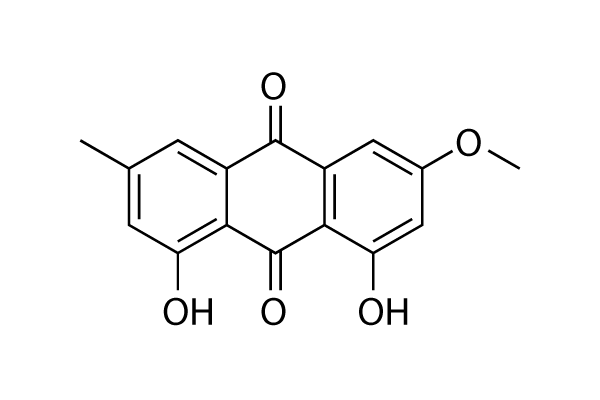All AbMole products are for research use only, cannot be used for human consumption.

Physcion is an anthraquinone from roots of Rheum officinale Baill.

Sci Rep. 2020 Oct 7;10(1):16769.
The effects of fructose and metabolic inhibition on hepatocellular carcinoma
Physcion purchased from AbMole
| Cell Experiment | |
|---|---|
| Cell lines | HeLa cells |
| Preparation method | HeLa cells were cultured in 96-well plates at a density of 5 × 103 cells/well. After 24 h, cells were washed with fresh medium and were treated with different concentrations of physcion. After the next 24 h of incubation, cells were washed two times with phosphate buffered saline (PBS) and 100 μl of MTT solution (1 mg/ml) was added to each well. |
| Concentrations | 1–10 μM |
| Incubation time | 24 h |
| Animal Experiment | |
|---|---|
| Animal models | male nude mice |
| Formulation | |
| Dosages | 40 mg and 20 mg/kg/day |
| Administration | i.p. |
| Molecular Weight | 284.26 |
| Formula | C16H12O5 |
| CAS Number | 521-61-9 |
| Solubility (25°C) | 10 mM in DMSO |
| Storage |
Powder -20°C 3 years ; 4°C 2 years In solvent -80°C 6 months ; -20°C 1 month |
| Related Antibiotic Products |
|---|
| Puromycin-d3
Puromycin-d3 is the deuterium labeled Puromycin. Puromycin dihydrochloride is the dihydrochloride salt of puromycin. Puromycin is an aminoglycoside antibiotic that inhibits protein synthesis. |
| BSH-IN-1
BSH-IN-1 is a potent and covalent inhibitor of gut bacterial recombinant bile salt hydrolases (BSHs) with IC50s of 108 nM and 427 nM for B. longum BSH (Gram positive) and B. theta BSH (Gram negative), respectively. |
| AAA-10
AAA-10 is an orally active gut bacterial bile salt hydrolases (BSH) inhibitor, with IC50s of 10 nM, 80 nM against B. theta rBSH and B. longum rBSH respectively. |
| Gut restricted-7
Gut restricted-7 (GR-7) is a potent, covalent and orally active pan-bile salt hydrolase (BSH) inhibitor. Gut restricted-7 has a tissue-selective and is restricted to the gut. Gut restricted-7 decreases gut bacterial BSHs and decreases deconjugated bile acid levels in feces of mice. |
| N-Hydroxypipecolic acid
N-Hydroxypipecolic acid (1-Hydroxy-2-piperidinecarboxylic acid), a plant metabolite and a systemic acquired resistance (SAR) regulator, orchestrates SAR establishment in concert with the immune signal salicylic acid. N-Hydroxypipecolic acid accumulates systemically in the plant foliage in response to pathogen attack. N-Hydroxypipecolic acid induces SAR to bacterial and oomycete infection. |
All AbMole products are for research use only, cannot be used for human consumption or veterinary use. We do not provide products or services to individuals. Please comply with the intended use and do not use AbMole products for any other purpose.


Products are for research use only. Not for human use. We do not sell to patients.
© Copyright 2010-2024 AbMole BioScience. All Rights Reserved.
